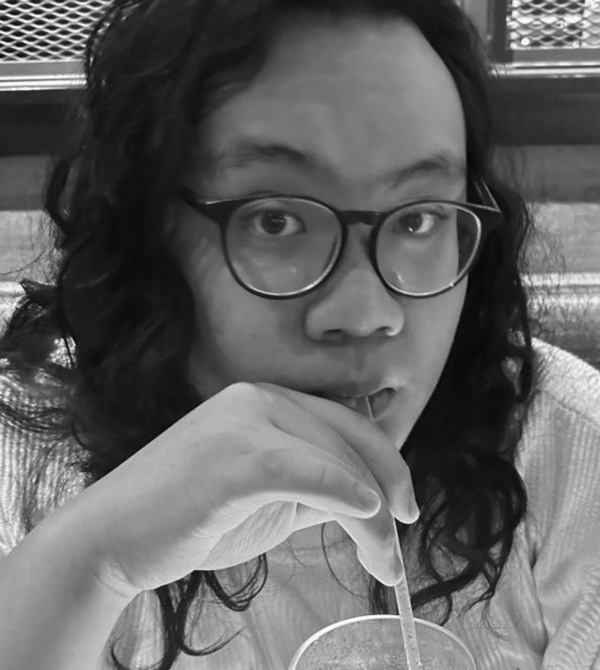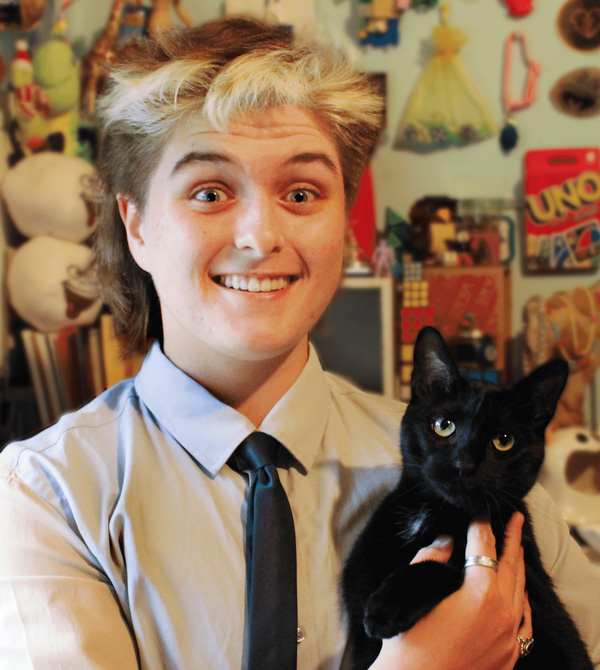
Jacob Nguyen

AP DRAWING
Herbert Henry Dow High School|Midland, Michigan


Dimensions: 20”x 29”|Material(s): Acrylic paint, Colored Pencil, on found pallet.|Process(es): The rough and wild hair complements the grainy and splintered texture of the board, expressing self.|Curatorial Note: The self-portrait uses the body to create a range of expression and emotion. The personal struggles can be seen in the textured lines of entanglement and the contrasting movement of crows and feathers in the hair and the background. The use of the pallet (found object) reinforces the idea of abandonment and despair.
Student statement
Student statement
Tóc giống tổ quạ (tahp yahm toe wah) is Vietnamese for hair like a crow’s nest; it was a phrase my family lovingly teased me with when my hair became large and curlier, unlike my family's shiny, straight black hair. Crow’s Nest/Tổ Quạ takes this idea literally; my head and hair are held up by my hands proudly as I let her and her young nest in my hair. I found the pallet in the garbage and felt inspired by the natural texture of wood, and it reminded me of the resourcefulness of crows as well. I took risks and painted a lot on many unconventional surfaces than just canvas or wood panels, as it added depth to the idea I was painting.
My sustained investigation explores the connection between self-portraiture and personal struggles with identity and mental health. This investigation was instrumental in my growth as it allowed me to make difficult emotions and memories tangible so those terrible feelings didn’t feel insurmountable.
My Studio Art teacher, Mr. Gledhill, was my biggest cheerleader, giving me and his other students much support, especially when things became rough due to external stressors. He also knew when to challenge and push your limits. He cultivated a classroom that encourages assistance from him and each other as a class. Studio Art was a lively class, with each student working on different themes and mediums. These unique perspectives gave me helpful new ways to demonstrate things through my work. This open and diverse class, with so many options, allowed me to experiment with combinations of different mediums and expand further on ideas by connecting them to the material.
Ultimately, my advice to students who plan on taking AP Art and Design and need an inquiry is the same as Mr. Gledhill’s advice: choose an investigation you have endless ideas about—something that you can constantly meditate and experiment on, whether it be a passion, subject, or introspection. But most importantly, it is an inquiry where you can have fun tinkering and taking risks.

How can I use self-portraits to represent my struggles? How can I represent my grievances through different lenses, interpreting grief in feelings of despair, longing, apprehension, and guilt? I connect emotions to various mediums, for example, using found objects from trash to emit abandonment and selecting meaningful textures- abrasive marks of uncertainty.
Teacher statement
Teacher statement

Curtis Gledhill
Jacob is a rare student, and I say that in my final year of public school art education. In 27 years, I've had 2 or 3 students at his level. His appetite for investigation and experimentation is voracious. He spends a great deal of time outside of the school hours working and perfecting his skills. He is well-versed in both 2-D and 3-D media. This allows him to deliver his message in the best way possible. I tell all my students that the larger their toolbox, the more capable they will be in delivering their intended messages.
While in my class, Jacob experimented with alternative grounds: painting on cardboard, glass, and here on a piece of old pallet that his dad had thrown on the burn pile. Jacob was always paying attention—constantly aware of what was around him. Nothing was off-limits. Sometimes, he had an idea and found the best materials to use. Other times, he found some odd item (like a four-pane glass door in his neighbor's garbage out on the road) and created a piece from the inspiration of the item.
Jacob was a generous and gracious learner as well. Our class was set up so we had many formal and informal critiques. He and I or he and his peers would discuss his work, searching for ways to communicate the message more clearly. He also quickly offered hints and techniques to his peers about how he would work with a particular material. Students would approach him and ask how he was getting such rich and complex skin tones, for example, and he would take the time to explain his methods and color choices, even to the point of going back to their pieces with them and guiding them as to how they could find similar success. I just tried to stay out of their way. The fact that Jacob is looking at art education as a possible career is a natural fit. I have been truly blessed to be Jacob's instructor.
Jacob Nguyen





